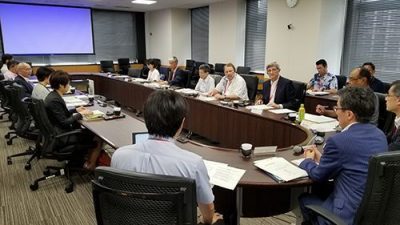High costs at OIST, one of the top research universities in the work? Japan’s Ministry of Finance instructs the school to strengthen research results

The Okinawa Institute of Science and Technology (OIST)
September 13, 2019 Ryukyu Shimpo
Tokyo – Japan’s Cabinet Office opened an investigative commission to discuss future challenges for the Okinawa Institute of Science and Technology (OIST) Graduate School September 12.
In June, the Ministry of Finance released an expenditure review, where it identified “high-cost structures,” and criticized OIST, saying, “(Compared to other similar institutions), the school is high cost in nature, and as such needs to be remedied immediately.
Judging it based on the policy that as costs rise, so should the level of research, we cannot see the value here.”
The MoF expressed their doubts in comparing OIST, meant to be a world-class University for education and research, to other universities.

Conference attendees discussing the future of the OIST graduate school. September 12, the Cabinet Office in Tokyo
In response to the demand for OIST to drastically change their high-cost structure, the university stressed, “In the mere eight years since the founding of the school, there have already been preeminent research results produced.”
The institution pointed to a survey by the English science magazine Nature, which looks into the ratio of high-quality thesis papers, excluding Tokyo University, OIST was this ranked highest in Japan, and ninth highest in the world, arguing that, “the efficiency of spending is on par with global competitors.”
The MoF also indicated the national grant given to the school for their operating budget, which has one faculty member for every 60 employees, is 268 million yen, remarkably higher than the 22 million provided to the Tokyo Institute of Technology, to which OIST responded, “The faculty employ researchers to conduct research.
There are a total of 301 researchers, and the per capita grant is only 53 million yen.”
They also indicated that the grant was lower than the federal grant provided to the California Institute of Technology.
The MoF also demanded that they increase outside funding, but OIST explained that the stable source of “high trust funding” in the form of government assistance led directly to international competitiveness.
Not only does it allow them to attract superior researchers to the institution, but within that, “If we tell people they need to secure outside funding to do research before coming to Japan, the first-class researchers simply will not come.”
At the conference, OIST was informed that the amount being requested for OIST in the 2020 budget was 16.3 billion yen for operating costs, which include research funds, and a little over 4 billion yen for the construction of a new research building.
(English translation by T&CT and Sam Grieb)
Previous Article:Mid-Autumn Celebration: A moonlit fall equinox dance performance at Shurijo Castle Park
Next Article:JTA to offer Okinawa-Vietnam charter flights
[Similar Articles]
- Dr. Gruss to be the next president of OIST Graduate University
- Springer Nature ranks Okinawan graduate university as 10th best research institution worldwide
- OIST to set up venture capital company
- Ceremony marking the establishment of the Okinawa Institute of Science and Technology Graduate University
- Okinawa Institute of Science and Technology opens in Okinawa
 Webcam(Kokusai Street)
Webcam(Kokusai Street)


